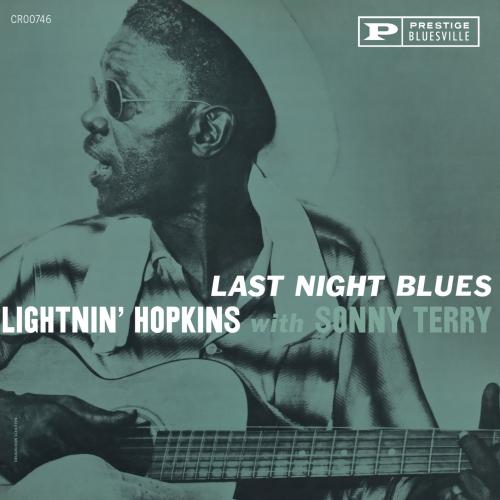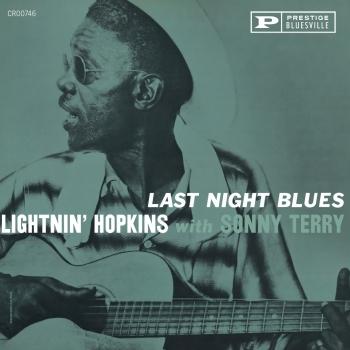
Last Night Blues (Remastered 2024) Lightnin' Hopkins & Sonny Terry
Album Info
Album Veröffentlichung:
2024
HRA-Veröffentlichung:
13.09.2024
Label: Craft Recordings
Genre: Blues
Subgenre: Acoustic Blues
Interpret: Lightnin' Hopkins & Sonny Terry
Das Album enthält Albumcover
Entschuldigen Sie bitte!
Sehr geehrter HIGHRESAUDIO Besucher,
leider kann das Album zurzeit aufgrund von Länder- und Lizenzbeschränkungen nicht gekauft werden oder uns liegt der offizielle Veröffentlichungstermin für Ihr Land noch nicht vor. Wir aktualisieren unsere Veröffentlichungstermine ein- bis zweimal die Woche. Bitte schauen Sie ab und zu mal wieder rein.
Wir empfehlen Ihnen das Album auf Ihre Merkliste zu setzen.
Wir bedanken uns für Ihr Verständnis und Ihre Geduld.
Ihr, HIGHRESAUDIO
- 1 Rocky Mountain (Remastered 2024) 04:55
- 2 Got To Move Your Baby (Remastered 2024) 04:04
- 3 So Sorry To Leave You (Remastered 2024) 04:23
- 4 Take A Trip With Me (Remastered 2024) 05:07
- 5 Last Night Blues (Remastered 2024) 05:19
- 6 Lightnin's Stroke (Remastered 2024) 04:58
- 7 Hard To Love A Woman (Remastered 2024) 04:04
- 8 Conversation Blues (Remastered 2024) 04:00
Info zu Last Night Blues (Remastered 2024)
Lightnin Hopkins war ein US-amerikanischer Blues-Sänger und-Gitarrist und darüber hinaus ein einflussreicher Vertreter des Texas Blues. Zusammen mit Sonny Terry, dem begnadeten Mundharmonikaspieler und Blues Vocalist, veröffentlichte er 1961 das grandiose Album Last Night Blues.
Craft Recordings und Bluesville Records werden am 13. September 2024 einen Klassiker der Bluesmusik wieder veröffentlichen und dabei handelt sich um die Platte "Last Night Blues" von Lightnin' Hopkins mit Sonny Terry aus dem Jahr 1961. Das Label startete dieses Jahr mit Bluesville Records eine neue Reissue-Reihe, die legendäre Blueskünstler und deren Einfluss auf die moderne Musik würdigt.
Der aus Houston stammende Sam 'Lightnin' Hopkins (1912-1982) zählt zu den produktivsten Künstlern der Bluesmusik, der sowohl für seine technischen Fähigkeiten auf der Gitarre als auch für seine Poesie als Songschreiber bewundert wurde. In seiner über vier Jahrzehnte währende Karriere beeinflusste er Generationen von Künstlern (u. a. Townes Van Zandt und Stevie Ray Vaughan). Er arbeitete oft mit Folk-Helden, Rock-Stars und zahllosen Blues-Kollegen zusammen, darunter der gefeierte Mundharmonikaspieler Sonny Terry. "Last Night Blues" erschien original 1961 bei Prestige Bluesville und war das zweite von drei gemeinsamen Alben der beiden Künstler.
Begleitet von Leonard Gaskin (Bass) und Belton Evans (Schlagzeug) bietet das reduzierte Set laut der Ankündigung eine intime Atmosphäre, in der das Zusammenspiel zwischen Hopkins und Terry in den Mittelpunkt rücken soll. Das Album enthält sieben Eigenkompositionen von Hopkins und eine mit Terry geschriebene Nummer.
Lightnin' Hopkins, Gitarre, Gesang
Sonny Terry, Mundharmonika, Gesang
Leonard Gaskin, Bass
Belton Evans, Schlagzeug
Digitally remastered
Sam (Lightnin’) Hopkins
blues singer and guitarist, was born in Centerville, Texas, on March 15, probably in 1911. Though some sources give his year of birth as 1912, his Social Security application listed the year as 1911. He was the son of Abe and Frances (Sims) Hopkins. After his father died in 1915, the family (Sam, his mother and five brothers and sisters) moved to Leona. At age eight he made his first instrument, a cigar-box guitar with chicken-wire strings. By ten he was playing music with his cousin, Texas Alexander, and Blind Lemon Jefferson , who encouraged him to continue. Hopkins also played with his brothers, blues musicians John Henry and Joel.
By the mid-1920s Sam had started jumping trains, shooting dice, and playing the blues anywhere he could. Apparently he married Elamer Lacey sometime in the 1920s, and they had several children, but by the mid-1930s Lacey, frustrated by his wandering lifestyle, took the children and left Hopkins. He served time at the Houston County Prison Farm in the mid-1930s, and after his release he returned to the blues-club circuit. In 1946 he had his big break and first studio session—in Los Angeles for Aladdin Recordings. On the record was a piano player named Wilson (Thunder) Smith; by chance he combined well with Sam to give him his nickname, Lightnin’. The album has been described as “downbeat solo blues” characteristic of Hopkins’s style. Aladdin was so impressed with Hopkins that the company invited him back for a second session in 1947. He eventually made forty-three recordings for the label.
Over his career Hopkins recorded for nearly twenty different labels, including Gold Star Records in Houston. On occasion he would record for one label while under contract to another. In 1950 he settled in Houston, but he continued to tour the country periodically. Though he recorded prolifically between 1946 and 1954, his records for the most part were not big outside the Black community. It was not until 1959, when Hopkins began working with legendary producer Sam Charters, that his music began to reach a mainstream White audience. Hopkins switched to an acoustic guitar and became a hit in the folk-blues revival of the 1960s.
During the early 1960s he played at Carnegie Hall with Pete Seeger and Joan Baez and in 1964 toured with the American Folk Blues Festival. By the end of the decade he was opening for such rock bands as the Grateful Dead and Jefferson Airplane. During a tour of Europe in the 1970s, he played for Queen Elizabeth II at a command performance. Hopkins also performed at the New Orleans Jazz and Heritage Festival. In 1972 he worked on the soundtrack to the film Sounder. He was also the subject of a documentary, The Blues According to Lightnin’ Hopkins, which won the prize at the Chicago Film Festival for outstanding documentary in 1970.
Some of his biggest hits included “Short Haired Women / Big Mama Jump!” (1947); “Shotgun Blues,” which went to Number 5 on the Billboard charts in 1950; and “Penitentiary Blues” (1959). His albums included The Complete Prestige /Bluesville Recordings, The Complete Aladdin Recordings, and the Gold Star Sessions (two volumes). Hopkins recorded a total of more than eighty-five albums and toured around the world. But after a 1970 car crash, many of the concerts he performed were on his front porch or at a bar near his house. He had a knack for writing songs impromptu, and frequently wove legends around a core of truth. His often autobiographical songs made him a spokesman for the southern Black community that had no voice in the White mainstream until blues attained a broader popularity through White singers like Elvis Presley. In 1980 Lightnin’ Hopkins was inducted into the Blues Foundation Hall of Fame.
Hopkins died of cancer of the esophagus on January 30, 1982, in Houston. He was survived by his caretaker, Antoinette Charles, and four children. His funeral was attended by more than 4,000, including fans and musicians. He was buried in Forest Park Cemetery in Houston. In 2002 the town of Crockett in Houston County, east of the birthplace of Hopkins, erected a memorial statue honoring the bluesman in Lightnin’ Hopkins Park. He is also honored in the Houston Institute for Culture's Texas Music Hall of Fame. In the 2010s a documentary, Where Lightnin’ Strikes, was in production.
Dieses Album enthält kein Booklet










